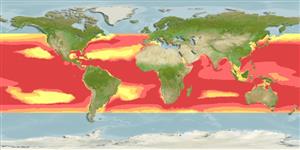Environment: milieu / climate zone / depth range / distribution range
Écologie
marin; océanodrome (Ref. 51243); profondeur 0 - 1000 m (Ref. 43). Subtropical; 22°C - 31°C (Ref. 43); 50°N - 45°S, 180°W - 180°E (Ref. 43)
Atlantic Ocean: in tropical and temperate waters. We follow Nakamura 1985 (Ref. 43) in recognizing Makaira mazara and Makaira nigricans as two distinct species chiefly because of differences in the pattern of the lateral line system. Many scientists, however, do not recognize this character as specifically diagnostic and consider the latter species as a single pantropical species occurring in the Atlantic, Pacific and Indian oceans. Highly migratory species.
Length at first maturity / Taille / Poids / Âge
Maturity: Lm ?, range 50 - ? cm
Max length : 500 cm TL mâle / non sexé; (Ref. 11441); 500.0 cm TL (female); common length : 290 cm TL mâle / non sexé; (Ref. 6659); poids max. publié: 636.0 kg (Ref. 40637); poids max. publié: 636.0 kg
Épines dorsales (Total) : 0; Rayons mous dorsaux (Total) : 45 - 50; Épines anales: 0; Rayons mous anaux: 19 - 23. Body blue-black above and silvery white below, with about 15 rows of pale cobalt-colored stripes; 1st dorsal fin plain blackish or dark blue, other fins brown black with a tinge of dark blue in some specimens; anal fin bases with a tinge of silvery white. Lateral line a network of interconnecting canals (Ref. 26938).
An oceanic species. Water color affects its occurrence, at least in the northern Gulf of Mexico, where the fish show preference for blue water. Rarely gathers in schools and usually found as scattered single individuals. Feeds mainly on fishes but also preys on octopods and squids. Marketed fresh or frozen (Ref. 43). Feeding takes place during daytime. Maturity reached at about 80 cm in males and 50 cm in females (Ref. 36731). Females grow larger (Ref. 4770). Recent study indicates maximum age close to 20 years using a series of deductions in the ¹⁴C dating method (Ref. 120707).
Subripe ova are opaque, white to yellow, and 0.3 to 0.5 mm in diameter. Transparent spherical eggs flowing out of a ripe ovary measured 1 mm in diameter.
Nakamura, I., 1985. FAO species catalogue. Vol. 5. Billfishes of the world. An annotated and illustrated catalogue of marlins, sailfishes, spearfishes and swordfishes known to date. FAO Fish. Synop. 125(5):65p. Rome: FAO. (Ref. 43)
Statut dans la liste rouge de l'IUCN (Ref. 130435: Version 2024-2)
Menace pour l'homme
Harmless
Utilisations par l'homme
Pêcheries: commercial; pêche sportive: oui
Outils
Articles particuliers
Télécharger en XML
Sources Internet
Estimates based on models
Preferred temperature (Ref.
123201): 11.5 - 27.3, mean 22.4 °C (based on 477 cells).
Phylogenetic diversity index (Ref.
82804): PD
50 = 0.7505 [Uniqueness, from 0.5 = low to 2.0 = high].
Bayesian length-weight: a=0.00427 (0.00255 - 0.00714), b=3.11 (2.96 - 3.26), in cm total length, based on LWR estimates for this species & (Sub)family-body (Ref.
93245).
Niveau trophique (Ref.
69278): 4.5 ±0.3 se; based on diet studies.
Generation time: 3.4 ( na - na) years. Estimated as median ln(3)/K based on 1
growth studies.
Résilience (Ref.
120179): Milieu, temps minimum de doublement de population : 1,4 à 4,4 années (K=0.1-0.3).
Prior r = 0.44, 95% CL = 0.29 - 0.66, Based on 6 full stock assessments.
Fishing Vulnerability (Ref.
59153): Moderate to high vulnerability (52 of 100).
Climate Vulnerability (Ref.
125649): Moderate to high vulnerability (50 of 100).
Nutrients (Ref.
124155): Calcium = 23.3 [9.7, 43.0] mg/100g; Iron = 0.898 [0.478, 1.711] mg/100g; Protein = 19.8 [18.5, 21.0] %; Omega3 = 0.245 [0.123, 0.499] g/100g; Selenium = 71.6 [34.5, 159.4] μg/100g; VitaminA = 3.61 [0.99, 13.41] μg/100g; Zinc = 0.283 [0.180, 0.446] mg/100g (wet weight);
